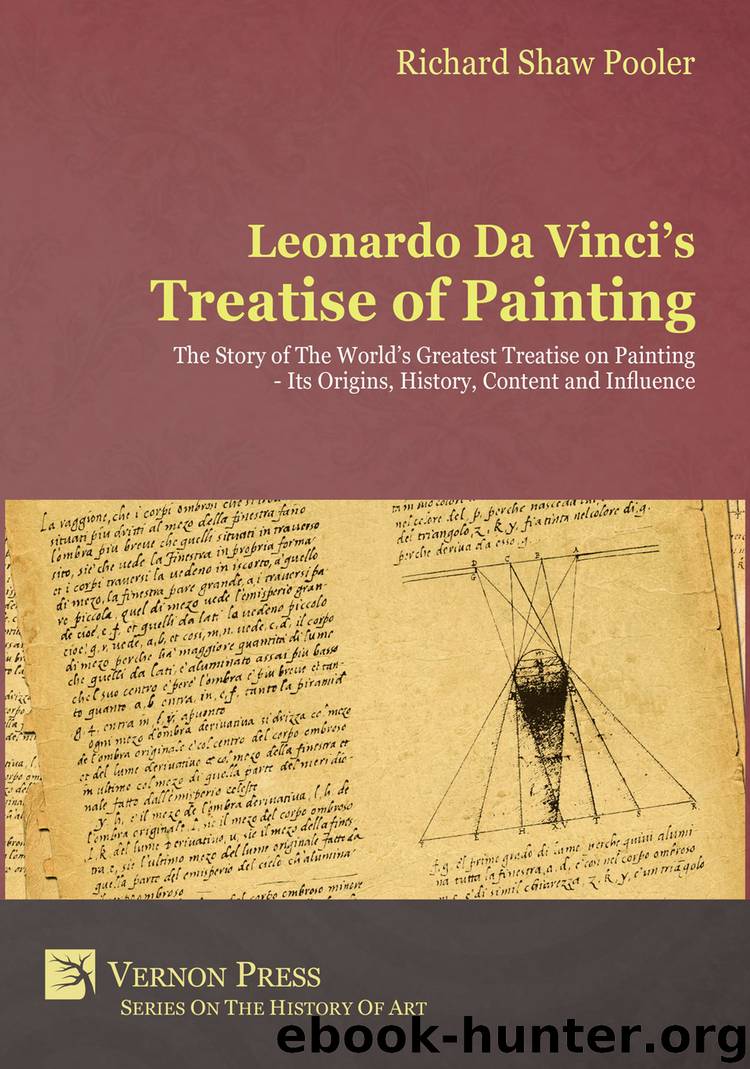Leonardo Da Vinci's Treatise of Painting: The Story of The World's Greatest Treatise on Painting - Its Origins, History, Content, And Influence. by Richard Shaw Pooler

Author:Richard Shaw Pooler [Pooler, Richard Shaw]
Language: eng
Format: epub
Publisher: Vernon Art & Science, Inc.
Published: 2016-04-19T21:00:00+00:00
Poussin's views had strongly influenced the Academie Royale in France, and through them many of Leonardo's ideas had been accepted, and promoted in subsequent teaching. The Academie Royale was founded in 1648 in Paris, to establish standards for Art. It was in 1651 that the Du Frêsne edition of the Traitté de la Peinture appeared in French and Italian. Leonardo's views, now readily available in published form, became the foundation for the standards laid down by the French Royal Academy of Fine Arts, and hence became National Art policy.
Awareness of Leonardo’s work, and the Treatise of Painting in particular, increased from about the middle of the 17th century after publication of the Du Frêsne editions in 1651. When the Du Frêsne editions were published, Art theory in France was in its infancy, and not yet established in any real sense. It had been developed in Italy, and at this stage was peculiar to the Italians. With the adoption of Leonardo’s Traitté in France, that was to change, but the change was gradual, and not without difficulty. The two major pre-occupations of the Académie at the time were the representation of the human figure, and perspective.
Leonardo encouraged students to study the figure in motion, and draw from life. Students at the Académie drew parts of the body from plaster casts, graduating to a posed model – not what Leonardo envisaged at all. This system slowed down the process of learning, controlling it and confining it within the bounds of reason and idealism, and it excluded the accidents of reality.
In 1698, a ‘Conference upon Expression’ took place at the Académie Royale addressed by Charles Lebrun,648 the Director of the Académie and the Premier Peintre du Roi, the text of which was published in 1667, a few years after the Du Frêsne edition. Many of the comments seem to be quoted almost directly from the Traitté de la Peinture. Lebrun said:
‘Expression...it is by that, the different natures of bodies are distinguished; that the figures seem to have motion, and that everything therein counterfeited appears to be real...the Eyebrow will be still more frowning than in the preceding Action;...the mouth will be open, but closer in the middle than at the corners, which ought to be drawn back...’649
The equivalent comments in the 1721 edition are,
‘The Motions of the Face, occasioned by sudden Agitations in the Mind, are very numerous;... The Knowledge of these Motions is of the last importance to a Painter, and his Figures without this will be dead in a double capacity;...his Eye-brows drawn down, and gathered close together, the sides of his Mouth bent into an Arch...’650
This is just one of several close similarities.
Drawing from a model was the approach encouraged by Charles Le Brun. In this he was opposed by artists and writers such as Charles-Alphonse Du Fresnoy,651 and Roger de Piles, and a bit later Denis Diderot652 who followed Leonardo’s dictum to draw from life, to capture real emotions of people in all walks of life – in short, to represent life realistically.
Download
This site does not store any files on its server. We only index and link to content provided by other sites. Please contact the content providers to delete copyright contents if any and email us, we'll remove relevant links or contents immediately.
Aircraft Design of WWII: A Sketchbook by Lockheed Aircraft Corporation(31772)
The Great Music City by Andrea Baker(21313)
Call Me by Your Name by André Aciman(18964)
The Art of Boudoir Photography: How to Create Stunning Photographs of Women by Christa Meola(17841)
Shoot Sexy by Ryan Armbrust(17141)
Plagued by Fire by Paul Hendrickson(16636)
The Secret History by Donna Tartt(16623)
Portrait Mastery in Black & White: Learn the Signature Style of a Legendary Photographer by Tim Kelly(16484)
Adobe Camera Raw For Digital Photographers Only by Rob Sheppard(16387)
Photographically Speaking: A Deeper Look at Creating Stronger Images (Eva Spring's Library) by David duChemin(16161)
Bombshells: Glamour Girls of a Lifetime by Sullivan Steve(13108)
Pimp by Iceberg Slim(12931)
Ready Player One by Cline Ernest(12837)
The Goal (Off-Campus #4) by Elle Kennedy(12433)
Art Nude Photography Explained: How to Photograph and Understand Great Art Nude Images by Simon Walden(12348)
Kathy Andrews Collection by Kathy Andrews(10519)
Thirteen Reasons Why by Jay Asher(7788)
Wonder by R.J. Palacio(7732)
Goodbye, Things by Fumio Sasaki(7728)
